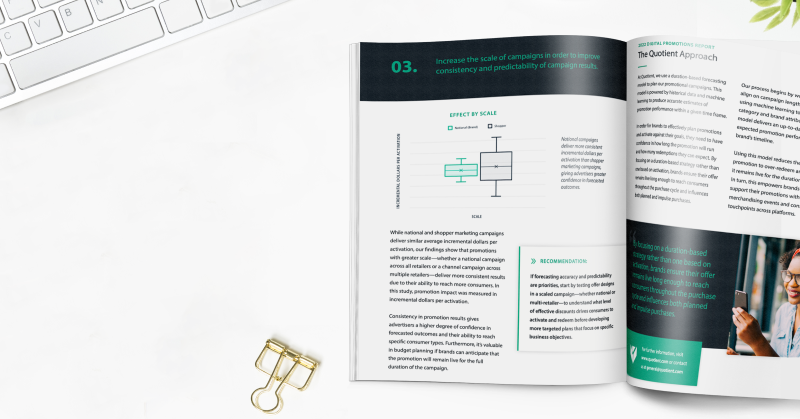For Digital Promotions, Greater Scale Means More Predictable Results
Taking a Closer Look at the 2022 Digital Promotions Report
Scale is the subject of our next look into the findings of our 2022 Digital Promotions Report. Critical to high-performing promotions, scale forms the backbone of Quotient’s durations-based approach to digital promotions, which uses historical data and machine learning to provide accurate estimates of promotion performance within a given time frame.
Compared to traditional activation-based promotions, duration-based promotions reduce the risk of over-redemption and help ensure offers remain live for the duration of the campaign. In turn, this empowers brands to confidently support their promotions with media, retail merchandising events and consumer activation touchpoints across platforms.
For more insight into the strategies found in our 2022 Digital Promotions Report, be sure to check out our previous posts on required purchase quantity and effective discount.
What Is Scale?
When we describe scale, what we’re really talking about is the reach of your promotion. The extent of that reach depends on whether the promotion is part of a shopper marketing campaign (available only at specific retailers) or a national campaign (available at all retailers).
While national campaigns inherently have more scale than shopper marketing campaigns, brands can increase the scale of shopper efforts by including more retailers in the campaign design. Shopper marketing campaigns can come to life as single-retailer campaigns or even channel campaigns that are available at all drug retailers or all grocery retailers, for instance. One of the most important distinctions for brands to recognize is that scale does not necessarily translate into better results, but more scale does allow advertisers to more accurately predict the impact that their promotions will drive.
How Does Scale Influence Digital Promotion Performance?
Where scale really comes into play is during the activation phase (when a consumer digitally clips or activates the coupon) and the impact phase (when the advertiser evaluates the measurable outcome that the promotion drove for their brand). In our study, promotion impact was measured by incremental dollars per activation, or the amount consumers spent on a product during a promotion above what they would have spent had they not engaged with the offer.
Scale ranked as the second-most important performance variable influencing activation. Our findings indicate that scaled campaigns—whether national or shopper marketing—drive more consistent and predictable levels of activation because they reach more people. A larger audience results in greater performance predictability and allows brands to focus their efforts on the tactics that work best for them. Interestingly, our study observed that national campaigns attracted the highest level of activation within the beverage, food and healthcare categories while shopper marketing campaigns saw their highest activation in personal care, household and pet care.
Since scaled promotions—generally national and multi-retailer campaigns—generate more consistent results because of their ability to reach more consumers, it’s not surprising that scale is the most significant variable when it comes to a promotion’s impact. If a brand cannot execute a promotion nationally, increasing the reach from a single retailer to a single channel can increase the predictability of the promotion’s forecasted impact.

We hope you enjoyed another deep dive into our 2022 Digital Promotions Report. Ready to see how a durations-based approach to digital promotions can work for your brand? Contact us at hello@quotient.com to start planning today.




